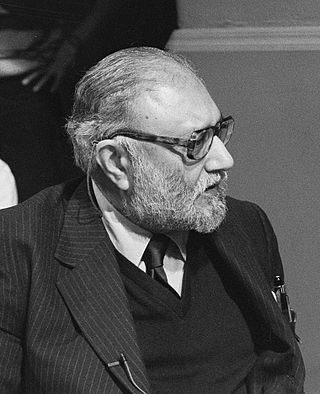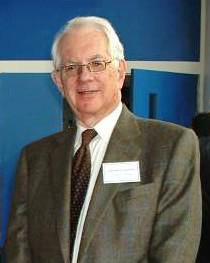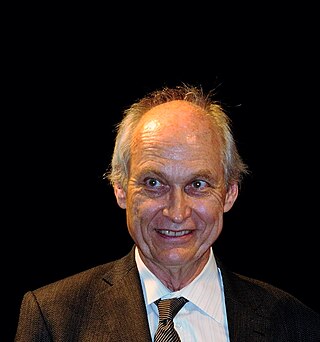Related Research Articles

Murray Gell-Mann was an American physicist who played a preeminent role in the development of the theory of elementary particles. Gell-Mann introduced the concept of quarks as the fundamental building blocks of the strongly interacting particles, and the renormalization group as a foundational element of quantum field theory and statistical mechanics. He played key roles in developing the concept of chirality in the theory of the weak interactions and spontaneous chiral symmetry breaking in the strong interactions, which controls the physics of the light mesons. In the 1970s he was a co-inventor of quantum chromodynamics (QCD) which explains the confinement of quarks in mesons and baryons and forms a large part of the Standard Model of elementary particles and forces.

Mohammad Abdus Salam was a Pakistani theoretical physicist. He shared the 1979 Nobel Prize in Physics with Sheldon Glashow and Steven Weinberg for his contribution to the electroweak unification theory. He was the first Pakistani and the first Muslim from an Islamic country to receive a Nobel Prize in science and the second from an Islamic country to receive any Nobel Prize, after Anwar Sadat of Egypt.

Sheldon Lee Glashow is a Nobel Prize-winning American theoretical physicist. He is the Metcalf Professor of Mathematics and Physics at Boston University and Eugene Higgins Professor of Physics, emeritus, at Harvard University, and is a member of the board of sponsors for the Bulletin of the Atomic Scientists.

David Jonathan Gross is an American theoretical physicist and string theorist. Along with Frank Wilczek and David Politzer, he was awarded the 2004 Nobel Prize in Physics for their discovery of asymptotic freedom. Gross is the Chancellor's Chair Professor of Theoretical Physics at the Kavli Institute for Theoretical Physics (KITP) of the University of California, Santa Barbara (UCSB), and was formerly the KITP director and holder of their Frederick W. Gluck Chair in Theoretical Physics. He is also a faculty member in the UCSB Physics Department and is affiliated with the Institute for Quantum Studies at Chapman University in California. He is a foreign member of the Chinese Academy of Sciences.

Michael S. Turner is an American theoretical cosmologist who coined the term dark energy in 1998. He is the Rauner Distinguished Service Professor Emeritus of Physics at the University of Chicago, having previously served as the Bruce V. & Diana M. Rauner Distinguished Service Professor, and as the assistant director for Mathematical and Physical Sciences for the US National Science Foundation.

Artur Konrad Ekert is a British-Polish professor of quantum physics at the Mathematical Institute, University of Oxford, professorial fellow in quantum physics and cryptography at Merton College, Oxford, Lee Kong Chian Centennial Professor at the National University of Singapore and the founding director of the Centre for Quantum Technologies (CQT). His research interests extend over most aspects of information processing in quantum-mechanical systems, with a focus on quantum communication and quantum computation. He is best known as one of the pioneers of quantum cryptography.
Francis Edwin Close, is a particle physicist who is Emeritus Professor of Physics at the University of Oxford and a Fellow of Exeter College, Oxford.
Serge Rudaz is a Canadian theoretical physicist and professor of physics at the University of Minnesota. He previously served as the director of undergraduate studies of the University of Minnesota's physics department, and is now the director of undergraduate honors at the University of Minnesota. Rudaz received his Ph.D. in 1979 from Cornell University and his undergraduate degree from McGill University.

Richard Henry Dalitz, FRS was an Australian physicist known for his work in particle physics.
The MIT Center for Theoretical Physics (CTP) is the hub of theoretical nuclear physics, particle physics, and quantum information research at MIT. It is a subdivision of MIT Laboratory for Nuclear Science and Department of Physics.
Arie Bodek is an American experimental particle physicist and the George E. Pake Professor of Physics at the University of Rochester.
Alexey A Petrov is an American physicist known for his theoretical research in the area of physics of heavy quarks. Petrov is a USC Endowed Chair in Physics and the chair of the Department of Physics and Astronomy at the University of South Carolina. Previously he was a professor of physics at Wayne State University. He is the first particle theorist in the State of Michigan to receive National Science Foundation's CAREER award
Michael John Creutz is an American theoretical physicist at Brookhaven National Laboratory specializing in lattice gauge theory and computational physics.

Richard Edward Taylor,, was a Canadian physicist and Stanford University professor. He shared the 1990 Nobel Prize in Physics with Jerome Friedman and Henry Kendall "for their pioneering investigations concerning deep inelastic scattering of electrons on protons and bound neutrons, which have been of essential importance for the development of the quark model in particle physics."
Hugh David Politzer is an American theoretical physicist and the Richard Chace Tolman Professor of Theoretical Physics at the California Institute of Technology. He shared the 2004 Nobel Prize in Physics with David Gross and Frank Wilczek for their discovery of asymptotic freedom in quantum chromodynamics.

Asoke Nath Mitra was an Indian theoretical physicist. He was a lifetime professor emeritus at Delhi University. He is known for his work in nuclear physics, particle physics and quantum field theory and in particular, for his fundamental contributions in obtaining the exact solution of the nucleon 3- body problem with separable potentials which led to the few nucleon studies, quark-recoil effect, development of an integrated dynamics of 2- and 3- body systems from nucleons to quarks as well as for the development of quark dynamics and relativistic quark models for hadrons in the Bethe-Salpeter framework. He was awarded the Shanti Swarup Bhatnagar Prize in 1969.
Marjorie Diane Blasius Corcoran was an American particle physicist who worked as a professor at Rice University.
Frederick Joseph Gilman is an American physicist and the Buhl Professor of Theoretical Physics Emeritus at Carnegie Mellon University.
Claude Pruneau is a Canadian-American experimental high-energy nuclear physicist. He is a professor of physics at Wayne State University and the author of several books. He is best known for his work on particle correlation measurements in heavy ion collisions at the Relativistic Heavy Ion Collider and the Large Hadron Collider.
Richard D. Field is Emeritus Professor of Physics at the University of Florida in Gainesville, Florida. He is known particularly for his contributions to the phenomenology of particle production in high-energy particle accelerators.
References
- ↑ "Dr. Richard Edward Hughes". Ohio State University. Retrieved 31 August 2020.
- ↑ "APS Fellow Archive" . Retrieved 31 August 2020.